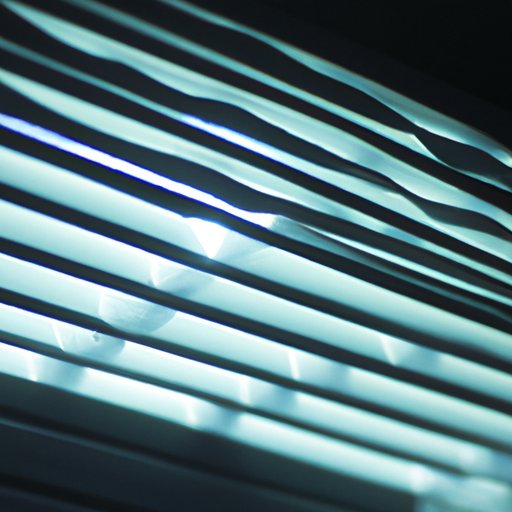
Introduction
Many people believe that they can get a tan through a window, while others dispute that claim. If you are wondering whether this is possible, then you have come to the right place. In this article, we will examine the science behind tanning and whether sunlight passing through glass can cause tanning. We will also discuss window treatments that can protect you from UV rays, provide sun-safe practices, and explore the benefits and risks of indoor and outdoor tanning.
Busting The Myth: Can You Actually Get a Tan Through a Window?
The short answer to this question is that it is indeed possible to get a tan through a window, but not all windows are created equal. Sunlight contains ultraviolet (UV) rays that stimulate melanin production, the substance responsible for skin pigmentation. The amount of UV rays that penetrate a window depends on the type of glass, with traditional windows typically filtering out most UVB rays, which are responsible for most of the sunburn-causing and cancer-causing effects of sunlight, but not UVA rays, which are responsible for much of the tanning effect and are linked to premature skin aging and a variety of skin cancers.
The Science Behind Tanning Through a Window
UV rays are responsible for both the beneficial and harmful effects of sunlight. On one hand, they convert a form of cholesterol in the skin to vitamin D, a necessary nutrient for bone health that has also been linked to cancer prevention and other health benefits. On the other hand, excess exposure to UV rays can cause damage to the DNA in skin cells, potentially leading to skin cancer, as well as premature skin aging, sunburn, and immune suppression.
The type of glass in windows can also affect tanning. Clear glass filters out some UV rays, but not all of them. Tinted glass, which is becoming increasingly popular and has a higher percentage of UVA filtering capabilities, can filter some of the UV rays responsible for tanning, although it too does not block all UVA rays, and should not be relied upon to protect against skin damage or to avoid the need to be sun-safe.
Sun-Safe Practices: Protecting Your Skin From Harmful UV Rays
While it may be possible to get a tan through a window, it is still just as important to practice sun safety to protect your skin from harmful UV rays. This includes wearing protective clothing, such as long-sleeved shirts, pants, and wide-brimmed hats, and using sunscreen with an SPF of at least 30, even when you are inside. It is also advisable to avoid peak sun hours from 10 AM to 4 PM, when UV radiation is at its highest.
Window Treatments: How to Block UV Rays and Prevent Tanning
If you are concerned about tanning and skin damage, there are several types of window treatments you can use. Window films, for example, can block up to 99% of UV radiation and can be applied directly to the glass surface. Window shades, such as cellular shades, are another great option since they block a significant amount of UV rays while still allowing sunlight to pass through. Both of these treatments can help to protect your skin from harmful UV radiation while also providing greater privacy and energy savings. Depending on the design of the home or office, other options may also include adjustable or permanent louvers, shade screens, or tinting.
The Benefits of Indoor Tanning: Why You Don’t Need a Window
If you are looking for a way to get a tan that does not involve sunlight penetrating glass, consider indoor tanning, which involves exposing your skin to UV radiation under controlled conditions. Indoor tanning units emit UV rays that mimic the sun’s rays, with the advantage that the amount of UV radiation and time of exposure can be controlled, and can only tan areas of the body where UV radiation is directed. Indoor tanning can provide the benefits of UV radiation without the risks associated with UV exposure from the sun or window, such as uneven tanning, skin damage or cancer, and sunburn.
Tanning and Your Health: Risks and Benefits
While tanning may provide benefits such as vitamin D production, improved mood, and giving the appearance of healthier skin, there is growing evidence to suggest that the risks of tanning far outweigh the benefits. The American Cancer Society warns that exposure to UV radiation is a leading cause of skin cancer, with those who use indoor tanning devices up to 75% more likely to develop melanoma than those who do not. Other risks of tanning include cataracts, premature aging, and immune suppression. To avoid these risks, it is advisable to practice sun-safe behaviors and combine these practices with sunless tanning methods such as bronzers, spray tans, lotions, or wipes.
Conclusion
Getting a tan through a window is possible if enough UV radiation penetrates the glass, but it is still important to stay sun-safe and protect your skin from potential harm, especially the risk of skin cancer and premature aging. To protect yourself, it is advisable to use sunscreen, wear protective clothing, maintain proper indoor window treatments, and avoid overexposure to the sun, both indoors and out. If you prefer to get a tan, remember that there are safe ways to achieve it, including indoor tanning and sunless tanning options.





